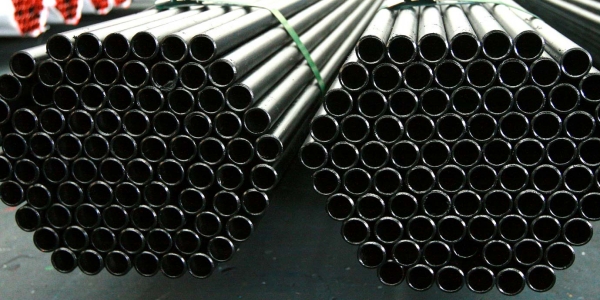Carbon steel pipe is strong, durable, resistant to corrosion and oxidation. Because of its strength and ability to withstand stress, carbon steel pipe is used in a variety of heavy-duty industries. Next, Union Steel will introduce the relevant knowledge of carbon steel pipes from two aspects of production process and standards.

Carbon Steel Pipe Production Process:
1. Raw material preparation
The main raw material of carbon steel pipes is carbon steel, usually hot-rolled or cold-rolled steel plates produced by steel mills are used as raw materials. In the raw material preparation process, the steel plate needs to undergo cutting, heat treatment and other processes to meet the requirements of steel pipe production.
2. Pipe billet heating
The cut steel plate is heated, usually by high-frequency induction heating or flame heating. The purpose of heating is to make the steel plate reach a certain temperature for the next step of forming.
3. Pipe blank forming
The heated steel plate is shaped by a forming machine. There are two common forming methods, one is cold rolling forming, which is to bend the steel plate into a tubular shape; the other is cold rolling forming, which is to bend the steel plate into a tubular shape. The other is hot rolling, which is to extrude the steel plate into a tube shape at high temperature. The formed tube blank needs to be cooled and straightened.
4. Welding process
There are two main welding processes for carbon steel pipes. One is resistance welding, which uses electric current to heat the two ends of the tube blank to melt and connect them together; the other is resistance welding, which uses electric current to heat the two ends of the tube blank to make them weld together. The other is arc welding, that is, the two ends of the tube blank are heated by an arc to melt and join together. The welded tube blank needs to be cleaned of welding slag and surface treated.
5. Pipe processing and welding
The tube blank is processed by cutting, flaring, trimming and other processing techniques to meet the requirements of different application occasions for the size and shape of the tube.
6. Pipe surface treatment
Derust and paint the surface of the pipeline to improve the anti-corrosion performance and aesthetics of the pipeline.
7. Pipe quality inspection
The physical properties, chemical composition, and dimensional accuracy of the produced pipes are tested to ensure that the quality of the pipes meets the standard requirements.
Carbon Steel Pipe Standard:
1. International standard
International standards for carbon steel pipes mainly include ASTM (American Society for Testing and Materials) standards, DIN (German Institute for Standardization) standards, JIS (Japanese Industrial Standards) standards, etc. These standards specify the requirements for the material, physical properties, chemical composition, and dimensional accuracy of carbon steel pipes.
2. Standard
The standard of carbon steel pipe is a standard formulated according to one's own needs, such as my country's GB/T (standard) standard. Standards usually refer to international standards and are adjusted and improved according to domestic actual conditions.
3. Industry standard
The industry standard of carbon steel pipe is the standard formulated by relevant industry organizations or associations, such as the API (American Petroleum Institute) standard for oil line pipe. Industry standards usually address the needs of specific application areas and put forward more specific requirements for the performance and quality of carbon steel pipes.
In summary:
The production process and standards of carbon steel pipes are very important to ensure the quality and performance of steel pipes. Through reasonable production technology and strict standard requirements, carbon steel pipes of good quality can be produced to meet the needs of various fields. When using carbon steel pipes, products that meet the requirements of the standards should be selected, and installed and used in accordance with relevant regulations to ensure their safety and reliability.

 English
English Español
Español




 Tel : +86-18565811709
Tel : +86-18565811709 Email :
Email : 

 News
News




